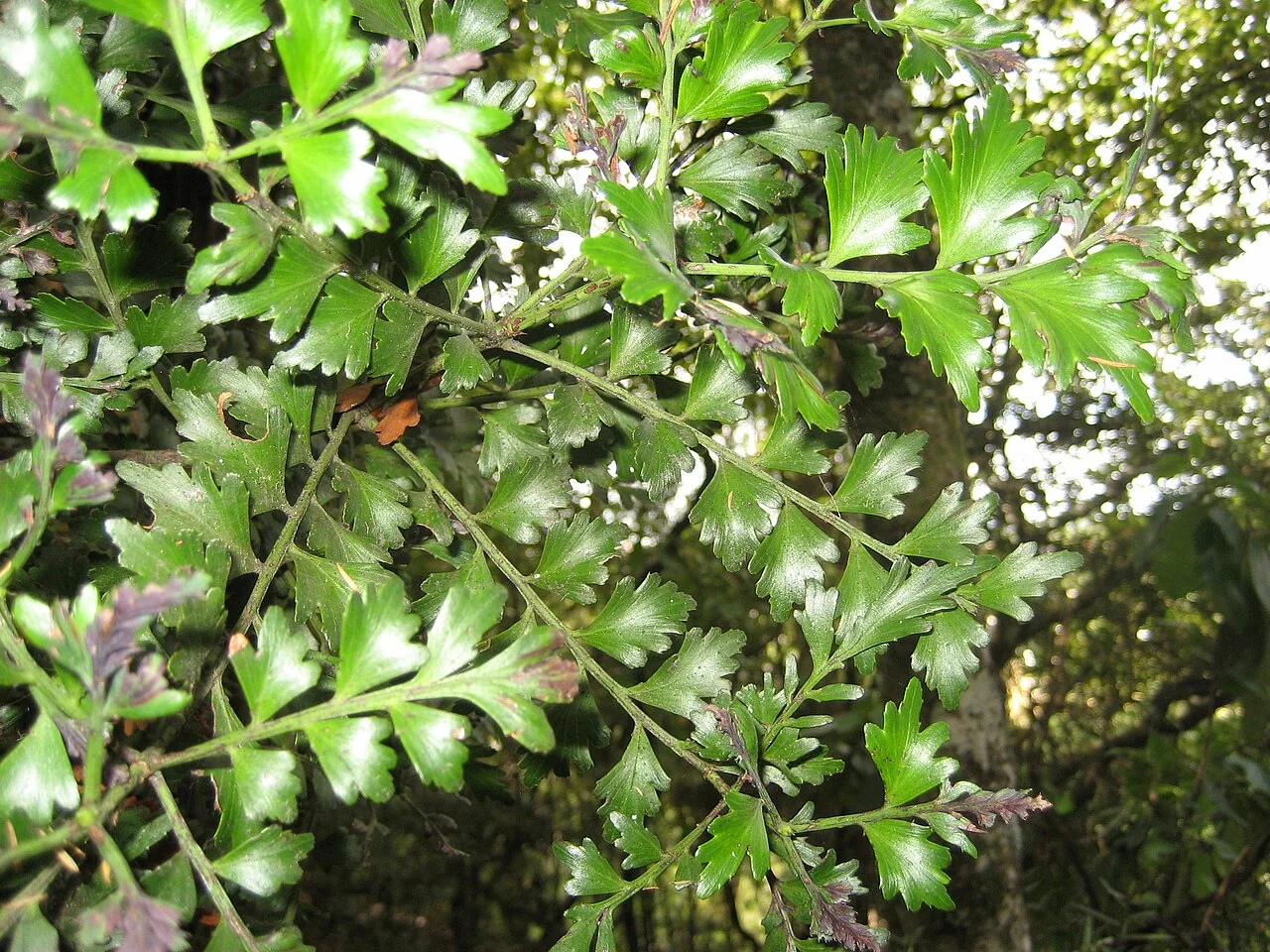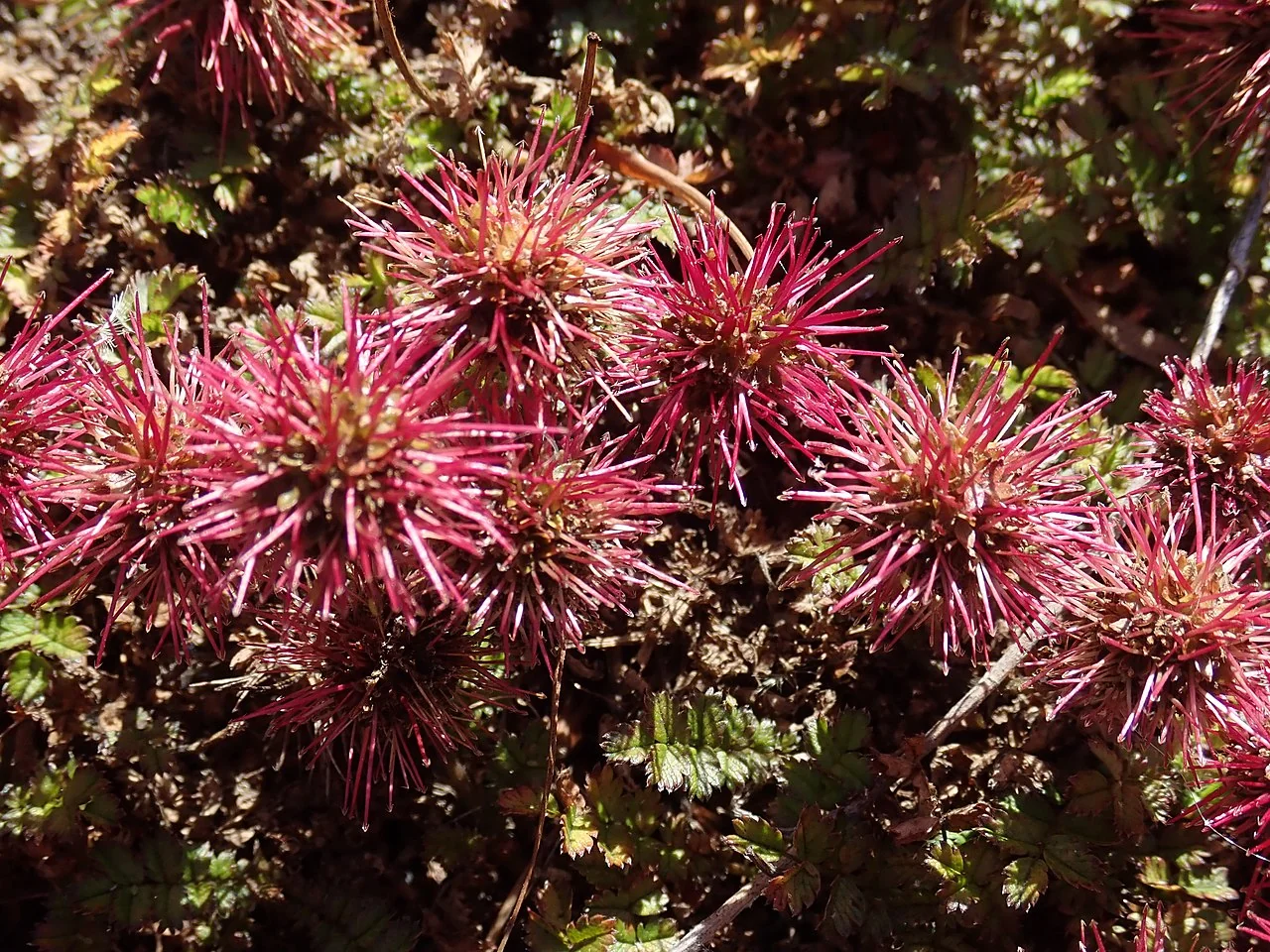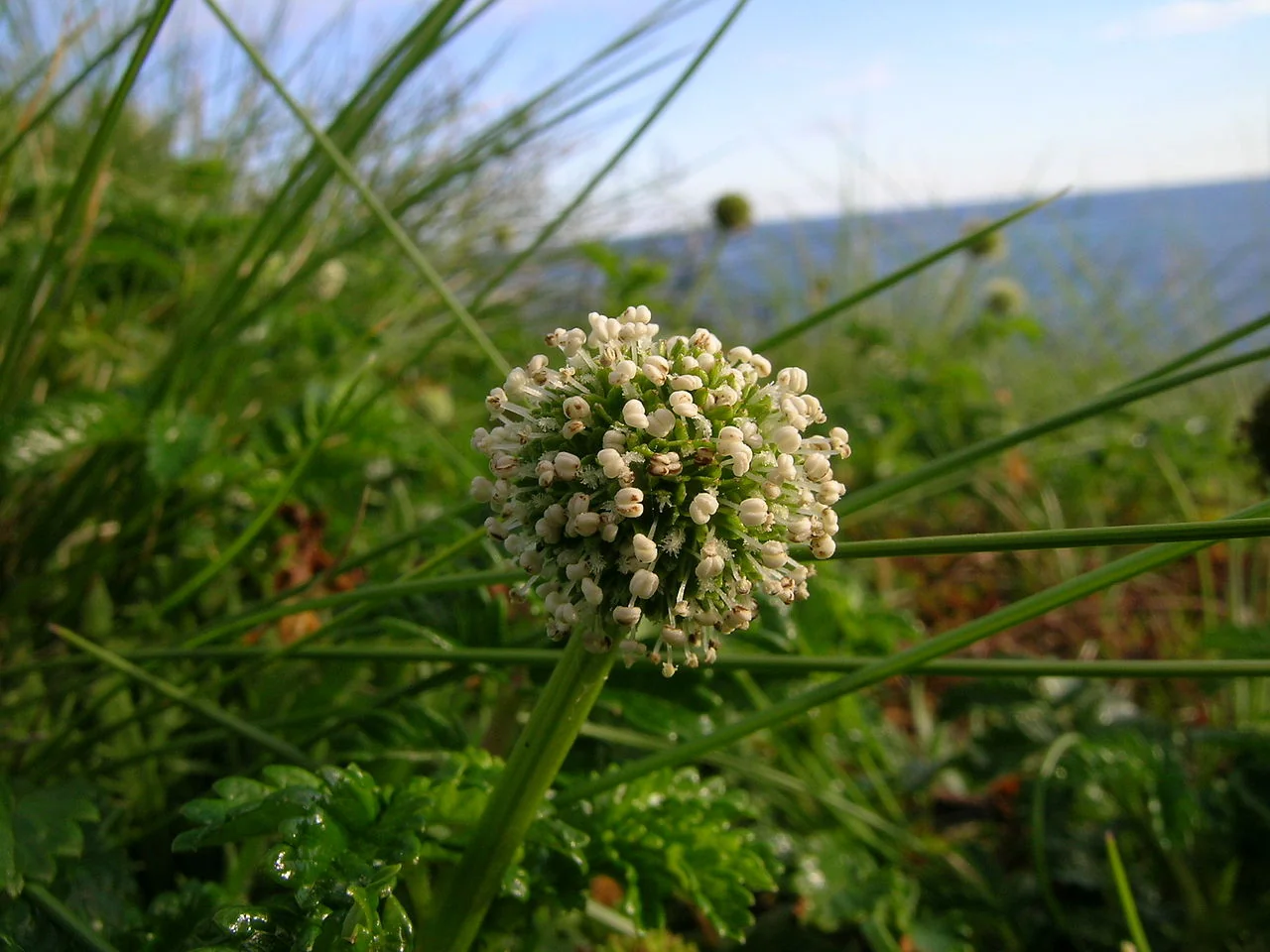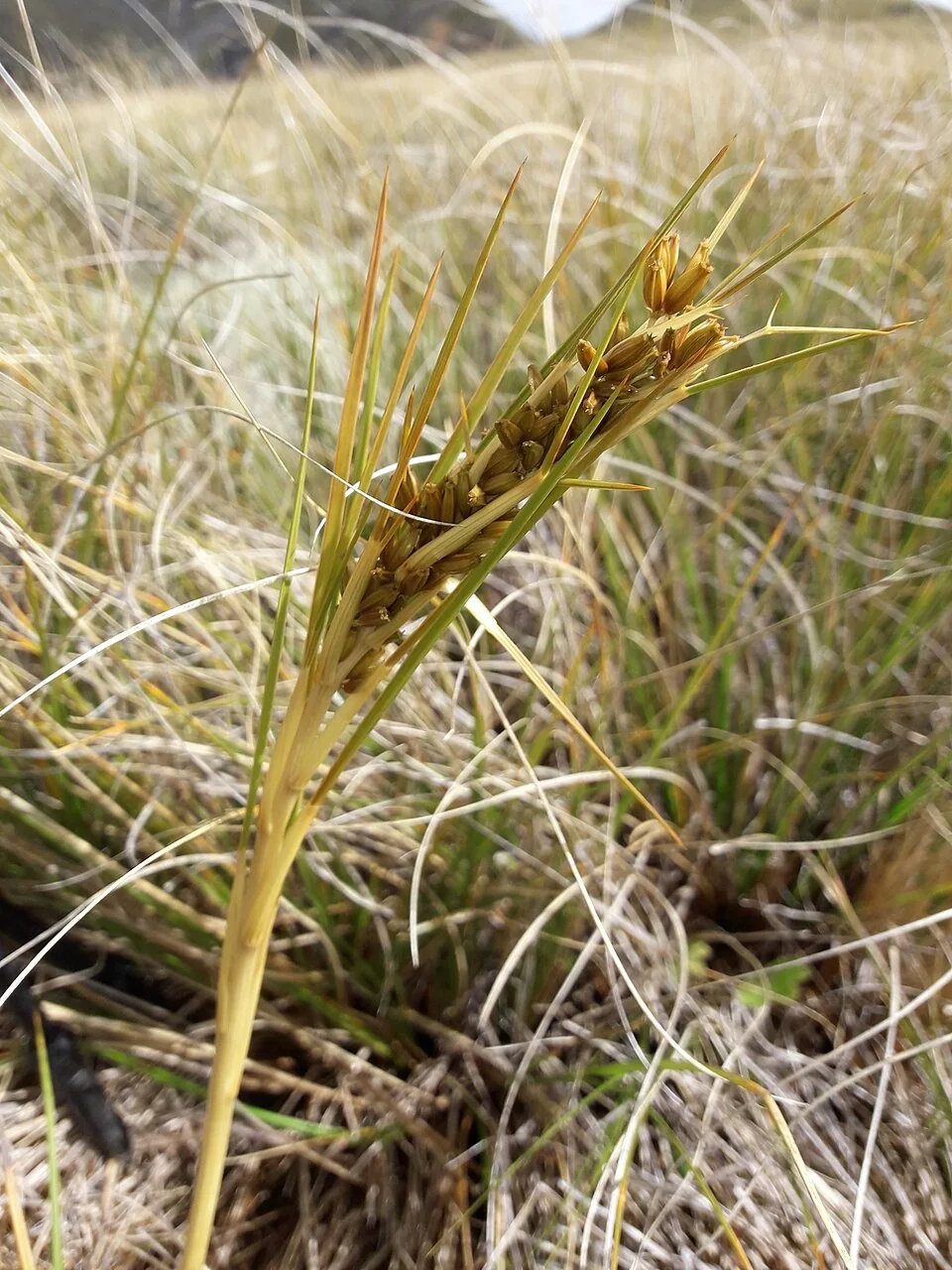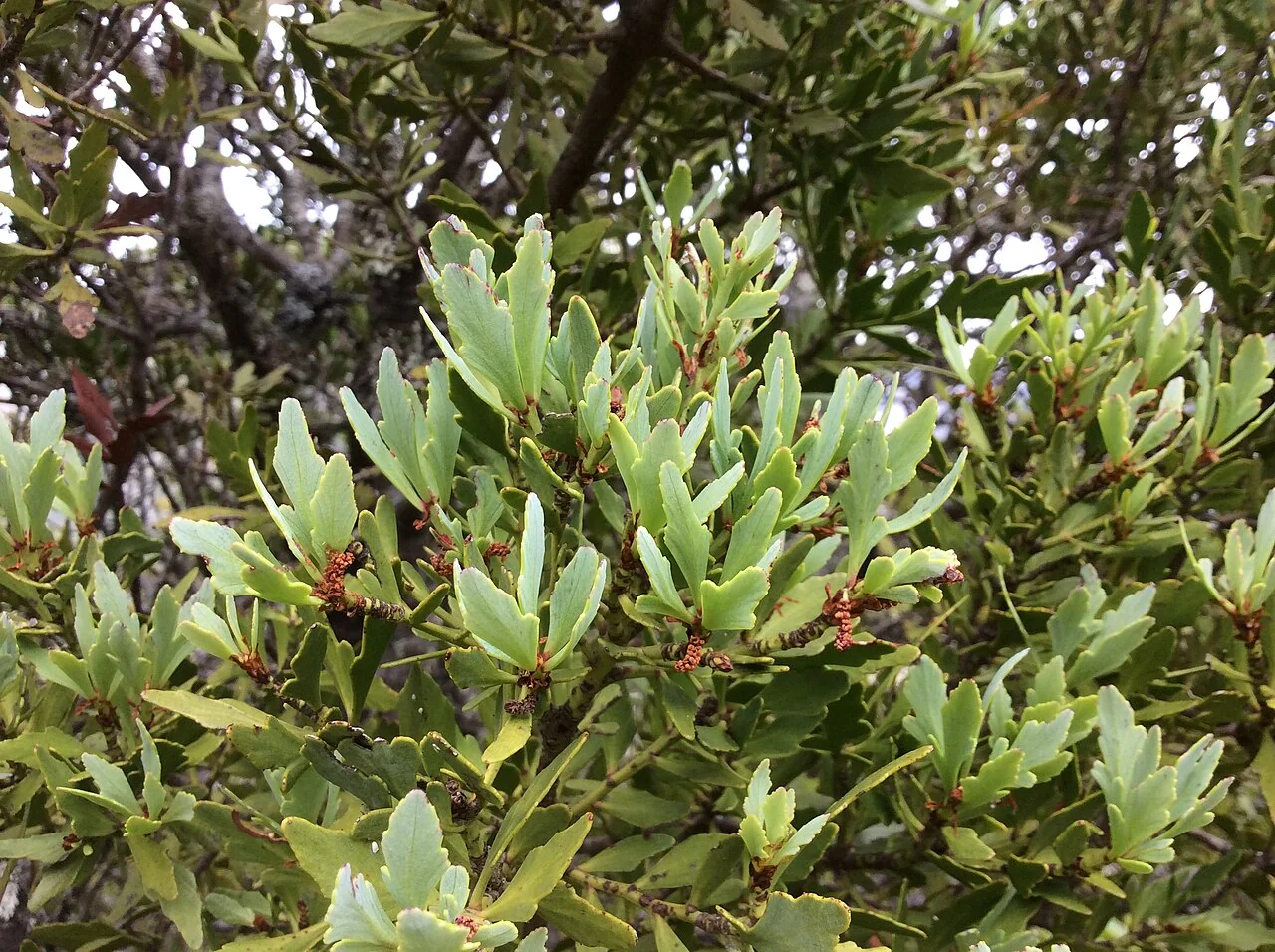
Mountain Toatoa
Phyllocladus alpinus
Mountain Toatoa is a hardy, compact evergreen conifer reaching 3-8 meters tall, characterized by its distinctive fan-shaped phylloclades (flattened branches that function as leaves) and ability to thrive in harsh alpine conditions. This resilient species forms a dense, often multi-stemmed shrub or small tree with unusual segmented "leaves" that give it a distinctive architectural appearance. Endemic to New Zealand's mountains, it's perfectly adapted to exposed sites with extreme weather and makes an excellent choice for challenging garden conditions among New Zealand's unique native trees .

Plant Description
Botanical Features
Mountain Toatoa ( Phyllocladus alpinus ), also known as mountain celery pine, is a species of conifer endemic to New Zealand. It typically grows as a monoecious, strongly aromatic shrub or a small tree, reaching up to 9 meters in height, with a short trunk up to 40 cm in diameter. True leaves are narrow-linear, acute, and deciduous, appearing mainly on seedlings and young plants, and are shorter on older plants. A distinctive feature is its phylloclades, which are flattened, photosynthetic, leaf-like stems. These phylloclades are alternate to subopposite, thick, and coriaceous, ranging from 1 to 2.5 cm (occasionally up to 6 cm) long and 2 cm wide in adults. Their shape varies, often being narrow-rhomboid, spathulate, elliptic, or obovate, with crenate margins and small leaf-denticles. They can be dark green to glaucous green above and glaucous below, sometimes appearing waxy bluish-green when young. Pollen cones are 5-6 mm long and found in clusters of 2-5. Female cones develop along the margins or on the stalks of the phylloclades, with a receptacle of red, fleshy scales, maturing into heads about 6-7 mm in diameter. The seeds are nut-like, black, ovoid, compressed, and approximately 2.5 mm long, partially enclosed by a white, irregularly lobed cupule.
Quick Facts
Quick Facts Overview
| Scientific Name | Phyllocladus Alpinus |
|---|---|
| Height | 3-8 meters |
| Spread | 3-6 meters |
| Water Needs | Low to moderate |
| Light | Full sun to partial shade |
| Frost Tolerance | Very high (hardy to -18°C) |
| Salt Tolerance | Low |
| Growth Rate | Slow |
| Lifespan | 150-300 years |
Climate Best Suited to
Mountain Toatoa thrives in subalpine and alpine climates from 900-1800 meters elevation, where it experiences cold winters with snow cover and cool summers. This extremely hardy species tolerates severe wind exposure, temperature extremes, and poor soils, making it ideal for challenging mountain garden conditions and exposed sites throughout New Zealand.
Regional Suitability
| Whangārei | Ideal |
| Auckland | Ideal |
| Hamilton | Suitable |
| Rotorua | Suitable |
| Tauranga | Ideal |
| Gisborne | Ideal |
| New Plymouth | Ideal |
| Whanganui | Ideal |
| Palmerston North | Suitable |
| Napier | Ideal |
| Wellington | Ideal |
| Nelson | Ideal |
| Christchurch | Suitable |
| Dunedin | Suitable |
| Invercargill | Suitable |
| City | Climate Suitability |
|---|
Plant Habitat
Plant Habitat Overview
This section provides important information about plant care and cultivation practices. Understanding these aspects helps ensure successful growth and development in garden conditions.
Plant Conservation
Conservation
Phyllocladus alpinus , commonly known as mountain toatoa or mountain celery pine, is a conifer species native to New Zealand. It is currently classified as "Least Concern" on the IUCN Red List and has been deemed "Not Threatened" under the New Zealand Threat Classification System, a status reaffirmed in 2018. Despite its generally secure conservation status, the species faces several challenges. Its naturally slow growth rate and specific high-altitude habitat requirements make it vulnerable. Introduced mammals pose a threat through browsing, which can hinder the plant's regeneration in accessible mountain regions. Additionally, climate change presents a long-term risk, as it could force the species into higher, more limited elevations. Conservation efforts for Phyllocladus alpinus are focused on protecting its alpine and subalpine forest habitats, managing and controlling introduced mammal pests in mountainous areas, and monitoring the impacts of climate change on this distinctive conifer and its specialized ecosystem. The species is widespread across both the North and South Islands of New Zealand, and its populations are increasing in some areas, particularly those previously affected by logging. It benefits from being present in several protected areas and from general government policies that safeguard native forests.
Growing Requirements
Soil Requirements
Mountain Toatoa is extremely adaptable to poor soil conditions:
- Thrives in poor, rocky, or gravelly soils with excellent drainage
- Tolerates shallow soils over rock or subsoil
- Cannot tolerate waterlogged or consistently wet conditions
- Prefers slightly acidic to neutral pH (6.0-7.5)
- Performs well in scree slopes and exposed ridge conditions
Light Requirements
Mountain Toatoa excels in exposed, sunny locations:
- Full sun preferred for compact, dense growth
- Excellent tolerance for high UV exposure at altitude
- Can handle extreme wind exposure once established
- Partial shade acceptable but may result in more open growth
Water Requirements
Mountain Toatoa is highly drought tolerant once established:
- Moderate watering during establishment period only
- Excellent drought tolerance once established (2-3 years)
- Natural rainfall usually sufficient in most locations
- Avoid overwatering which can cause root problems
- Benefits from winter snow cover in natural habitats
Planting Guide
When to Plant
Plant Mountain Toatoa during autumn or early spring in cool conditions. This alpine specialist establishes best when planted during cool, moist weather that mimics its natural mountain environment.
Site Selection
Choose a site with:
- Excellent drainage - absolutely essential for success
- Full sun exposure with good air circulation
- Rocky, gravelly, or poor soil conditions
- Protection appreciated during establishment, then full exposure tolerated
Planting Procedure
- Create raised planting area or choose naturally well-drained slope
- Mix native soil with coarse sand and gravel for drainage
- Plant at same depth as container level
- Backfill with free-draining soil mixture
- Water gently to settle soil without creating soggy conditions
- Stake if necessary to protect from wind during establishment
- Apply gravel mulch rather than organic mulch
Initial Care
Provide moderate watering during first year, allowing soil to dry between waterings. Mountain Toatoa becomes extremely hardy once established but needs care during initial root development.
Ecological Role
Environmental Impact
Mountain toatoa plays specialized ecological roles in New Zealand's alpine and subalpine forest ecosystems, where its distinctive phylloclade system and hardy growth form contribute to forest structure in challenging mountain environments. The tree provides habitat for mountain-adapted wildlife and supports communities of epiphytes and organisms specialized for high-altitude conditions. Its ability to establish and persist in harsh mountain environments makes it important for maintaining forest cover and preventing erosion on steep mountain slopes.
Uses Section
Uses Section Overview
This versatile native plant offers multiple practical applications in landscaping and garden design, from providing ground cover and erosion control to creating habitat for native wildlife. The plant 's natural characteristics make it valuable for restoration projects and sustainable gardening practices.
Cultural Significance
Cultural Importance
Alpine Conifer Identity
Mountain toatoa represents the resilience of New Zealand's high-country conifers. Featuring it in native conifer collections and restoration plantings highlights the diversity of southern podocarp-conifer forests.
Phyllocladus alpinus , commonly known as Mountain Toatoa or Mountain Celery Pine, holds significant cultural and ecological importance, particularly within Māori culture in New Zealand. The plant is known by Māori names such as Toatoa and Makatoatoa. The name "toatoa" is associated with "warrior," which may allude to the robust properties of its timber. While Phyllocladus alpinus itself is noted for its elastic and wind-resistant timber, its close relative, Phyllocladus trichomanoides (tānekaha), was highly valued by Māori for its strong, durable, and flexible wood. The bark of Phyllocladus alpinus was traditionally used by Māori to extract a brown dye, and sometimes a red dye. Southern Māori collected the bark of Phyllocladus alpinus and carried it as a personal scent, which was considered similar to a highly prized perfume. The inner bark of Phyllocladus alpinus (and tānekaha) was prepared by pounding and steeping it in water. This liquid was then consumed to treat ailments such as dysentery and diarrhea. It was also an ingredient in "Natanata," a patent medicine developed by Mother Suzanne Aubert, used for treating chronic stomach illnesses. Beyond its direct uses, Phyllocladus alpinus is ecologically significant in New Zealand. It supports native biodiversity, contributes to habitat structure, and is valued in restoration efforts. Within Mātauranga Māori (Māori knowledge systems), native plants like Mountain Toatoa are understood to be crucial for sustaining the health of the ngahere (forest) and local ecosystems. It plays specialized roles in alpine and subalpine forest ecosystems, providing habitat for mountain-adapted wildlife and helping to prevent erosion on steep slopes.
Landscaping Section
Landscaping Section Overview
This section provides important information about plant care and cultivation practices. Understanding these aspects helps ensure successful growth and development in garden conditions.
Seasonal Care Calendar
Spring
- New phylloclade growth begins slowly as temperatures rise
- Best time for planting in suitable alpine conditions
- Check for winter damage from snow load or wind
- Begin light watering schedule for newly planted specimens
Summer
- Active growing period with new phylloclade development
- Excellent tolerance for summer heat and UV exposure
- Minimal watering needed except during extreme drought
- Seeds develop on female plants during good growing years
Autumn
- Seeds mature with attractive red arils on female trees
- Good time for planting before winter weather
- Collect seeds for propagation when available
- Natural phylloclade drop occurs as part of normal cycle
Winter
- Outstanding cold tolerance with no protection needed
- Benefits from natural snow cover in mountain habitats
- Growth stops during coldest periods
- Perfect time for any necessary pruning
When to Prune and How Much
When to Prune and How Much Overview
Mountain Toatoa naturally develops excellent compact form requiring minimal intervention:
- Remove dead or damaged branches any time of year
- Light shaping possible but rarely necessary
- Avoid heavy pruning as phylloclades don't regenerate quickly
- Natural dense form usually most attractive
- Late winter best timing for any structural work
Use sharp , clean tools for precise cuts on the unique phylloclade structure. The slow growth means pruning mistakes are long-lasting, so work conservatively.
How to Grow Mountain Toatoa
Mountain Toatoa is a hardy, compact evergreen conifer reaching 3-8 meters tall, characterized by its distinctive fan-shaped phylloclades (flattened branches that function as leaves) and ability to thrive in harsh alpine conditions. This resilient species forms a dense, often multi-stemmed shrub or small tree with unusual segmented "leaves" that give it a distinctive architectural appearance. Endemic to New Zealand's mountains, it's perfectly adapted to exposed sites with extreme weather and makes an excellent choice for challenging garden conditions. Understanding its propagation methods is key to successfully growing this unique species.
From Seed
Propagating Mountain Toatoa from seed requires patience and specific conditions due to its slow germination and growth rates. Collect ripe seeds with red arils from female plants in autumn. Remove the fleshy aril coating and clean seeds thoroughly. Stratify seeds in moist sand at 4°C for 10-14 weeks to break dormancy. Sow in a very well-drained alpine seed mix. Maintain cool conditions (12-18°C) with excellent drainage. Germination is irregular and slow, often taking 8-16 weeks. Transplant seedlings when robust enough to handle (12-15cm). Seedlings are extremely slow-growing and may take 15-25 years to reach mature size in garden conditions.
From Cuttings
Vegetative propagation of Mountain Toatoa from cuttings is very challenging and generally has low success rates. Take small semi-hardwood cuttings from current year's growth. Use hormone treatment and an extremely well-drained cutting mix. Provide cool, humid conditions with excellent air circulation. Success rates are very low due to specialized requirements, and rooting may take 12+ months when successful. This method is best suited for experienced propagators or in specialized nurseries for conservation purposes.
Pests and Diseases
Root Rot (Rare)
- Cause: Poor drainage in lowland plantings
- Symptoms: Yellowing phylloclades , reduced growth, branch dieback
- Management: Improve drainage immediately; avoid overwatering; ensure good air circulation
Environmental Adaptation Issues
- Heat stress : May struggle in very hot, humid lowland conditions
- Symptoms: Phylloclade browning , reduced vigor in unsuitable climates
- Management: Provide cooler microclimate; consider alternative species for hot areas
Mechanical Damage
- Wind damage : Young plants may suffer from extreme wind exposure
- Snow damage : Heavy snow loads can break branches
- Management: Provide temporary shelter for young plants; prune damaged growth
Minimal Pest Issues
- Advantage: Very few pests affect this hardy alpine species
- Occasional: Minor scale insect issues on stressed lowland plants
- Prevention: Maintain optimal cool, well-drained conditions
Mountain Toatoa's extreme hardiness means it has very few pest or disease problems when grown in suitable conditions. Focus on proper site selection rather than pest management.
Bonus Tip
Expert Growing Advice
Mountain Toatoa is almost entirely devoid of true leaves. Instead, it has flattened stems called phylloclades that perform photosynthesis, giving it a distinctive appearance and the origin of its genus name.
